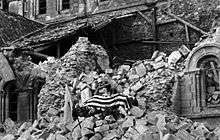Thomas D. Howie
| Thomas Dry Howie | |
|---|---|
 The flag-draped body of Maj. Thomas Howie rests on the rubble of the St. Lo Cathedral, 1944 (National Archives) | |
| Born |
April 12, 1908 Abbeville, South Carolina |
| Died |
July 17, 1944 (aged 36) near Saint-Lô, France |
| Allegiance |
|
| Service/branch | United States Army |
| Years of service | 1932–1944 |
| Rank | Major |
| Commands held | 3rd Battalion, 116th Infantry Regiment, 29th Division |
| Battles/wars | World War II |
| Awards |
Silver Star Bronze Star Purple Heart, Croix de Guerre |
Thomas Dry Howie (April 12, 1908 – July 17, 1944) was an American army officer, killed during the Battle of Normandy during World War II, while trying to capture the French town of Saint-Lô. He is known as "The Major of St. Lo".
Howie was born in Abbeville, South Carolina, and graduated in 1929 from The Citadel, where he was president of his class, star halfback on the football team and captain of the baseball team. He taught English and coached at Staunton Military Academy in Virginia; he was commissioned into the US Army Reserve in 1932 and in 1934 transferred to the Virginia National Guard's 116th Infantry Regiment, which was based at an armory in Staunton.
Howie entered active duty when the 29th Division was federalized in 1941. The unit moved to the United Kingdom in September 1942 and landed at Omaha Beach on D-Day; a little more than a month later, on July 13, 1944, Major Howie was assigned to command the 3d Battalion. On July 16, the 3d Battalion used hand grenades and bayonets to break through the German lines and join the 2d Battalion, which was isolated and nearly out of food and ammunition. Howie left the 2nd Battalion to defend the position, reporting that they were "too cut up", and planned to use the 3d Battalion alone to capture Saint-Lô. On the morning of July 17, Howie phoned Major General Charles Gerhardt, said "See you in St. Lo", and issued orders for the attack. Shortly afterward, he was killed by shrapnel during a mortar attack. The next day, the 3d Battalion entered Saint-Lô, with Howie's body on the hood of the lead jeep, at Gerhard's request, so that Howie would be the first American to enter the town. The photo of Howie's flag-draped body in the rubble of the St. Croix cathedral was widely circulated in the United States and became one of the most iconic images of the war; because of wartime security Howie's name could not be revealed, so it was famed New York Times correspondent Drew Middleton who dubbed Howie "The Major of St. Lo". 60 Minutes commentator Andy Rooney, then a reporter with the Stars and Stripes newspaper, witnessed the event and called it "one of the truly heartwarming and emotional scenes of a gruesome and frightful war".
The town of Saint-Lô erected a monument to Howie. In 1956, Collier's magazine printed a story, "The Major of St. Lo" by Cornelius Ryan; it was made into an episode of the TV show Cavalcade of America that was broadcast on June 5, 1956, with Peter Graves playing the part of Howie. The bell tower on the campus of The Citadel is named in Howie's memory, and a mural of his body being carried into St. Lo is one of a series on school history displayed in Daniel Library. Staunton Military Academy honored him by establishing a drill team called the Howie Rifles, which is now part of the Army ROTC detachment at Mary Baldwin College. Howie was posthumously awarded the Silver Star, the Bronze Star, the Purple Heart, and the French Legion of Honor; he is buried at the Normandy American Cemetery.
Further reading
- "Last Phase of the Battle". St. Lo. American Forces in Action Series. United States Army Center of Military History. 1994 [1946]. CMH Pub 100-13.
- Hammond, William H. Normandy. The U.S. Army Campaigns of World War II. United States Army Center of Military History.
External links
- Bio and Major Howie in Normandy 1944
- Text of a speech given by Howie in 2003
- Staunton Military Academy alumni
- "Cavalcade of America" The Major of St. Lo (1956) on IMDb